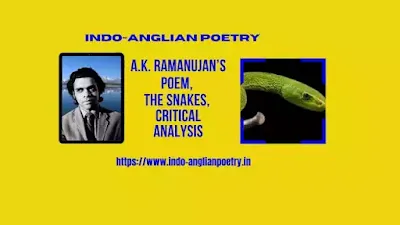Introduction of the Poem:
“Snakes” is a marvellous poem and holds us spell - bound though we are afraid of them in real life and tremble with fear even when we read about them. In this poem we are brought face to face with snakes and are confronted with them in all their reality. We are made to see the cobras and we are made to hear their hissing. And, of course, we are made to share the speaker's terror of them, though we are unable to share his sense of freedom because it is he who has killed a snake in his imagination, and got rid of his fear, not we. In any case, this poem gives rise to mingled feelings of wonder, terror, and partial relief.

The inspiration to write this poem seems to have come to Ramanujan from D.H. Lawrence's poem entitled Snake. In that poem the persona, on seeing a snake, reacts in the manner in which any human being would react; he picks up a stick and hurls it at the snake in order to kill it, but he misses the aim and the snake manages to escape into its underground kingdom where he is the sole monarch. The persona in Ramanujan's poem also reacts to a snake in much the same manner, but Ramanujan's poem is a much more elaborate affair.
Critical Analysis of the Poem
“The Snakes” is also included in The Striders. Ramanujan describes through evocative and precise images the habits and the physiognomy of snakes which always strike terror in human heart. The poet also conveys to the readers his terrors at the sight of the snakes. Paul Verghese writes: “the description of the snake reveals great skill in the use of images that are highly concentrated in their effect. The images have vividness, even in their abstractness."
The poet's observation is minute. The physical features of snakes, their smoothness, suppleness, and fluidity of movement, as described by the poet, have the authenticity of observation and experience. The snakes have “their brown wheat glisten ringed with ripples.” When the snake “licks the room with its body” writhing “a sibilant alphabet of panic on my floor”, we have an immediate sense of the “hissing snake” measuring its way across the room - its essential personality is realised vividly in terms of the panic it arouses in the beholder. The suggestiveness and picturesqueness of imagery is appreciable.
Ramanujan piles image on image in order to create mental picture of snakes on the mind of readers:
“The twirls of their hisses
rise like the tiny dust - cones on show - noon roads
winding through the farmer's feet
Black lorgnettes are etched on their hoods,
ridiculous, alien, like some terrible aunt,
a crest among tiles and scales
the moult with darkening half
of every moon.”
The childhood memories and terror of snakes are described through evocative images. The fear of the child is contrasted with the reverential and worthful attitude of the mother who gives milk to snakes and anxiously watches them emptying the saucer. The snake charmer is bold enough to make a garland of snakes round his neck. The child's imagination is haunted by snakes. He imagines his sister's braids with a knot of tassel and a score of clean pins to be snakes. All such impressions create a panic in him. His night is fearful from a
sadness
in a play
my left foot listens to my right footfall
a clockwork clicking in the silence
within my walking.
But, when he grew up he dared to tread a snake. He left the snake sealed, a flat head whiteness on a stain. The poem concludes with a note of irony:
“Now
frogs can hop upon this sausage rope;
flies in the sun will nab the look in his eyes
and I can walk through the woods.”
“The Snakes” successfully renders the memory of a childhood experience. The comparison between the past when snakes filled his heart with fear and the present when he can fearlessly trample snakes is striking.
